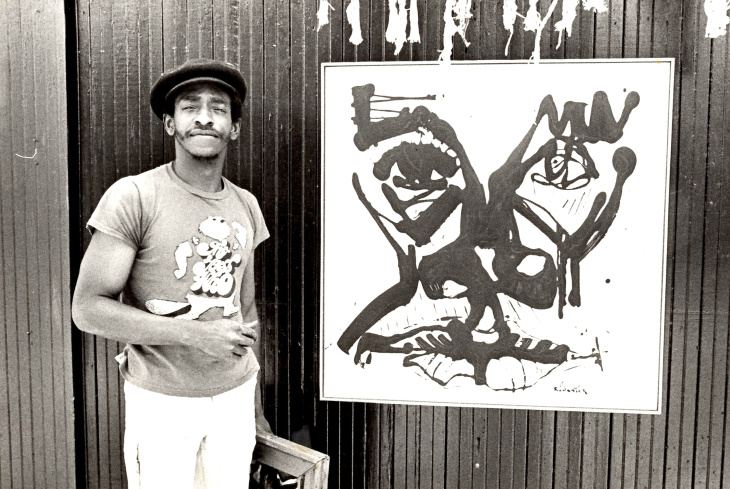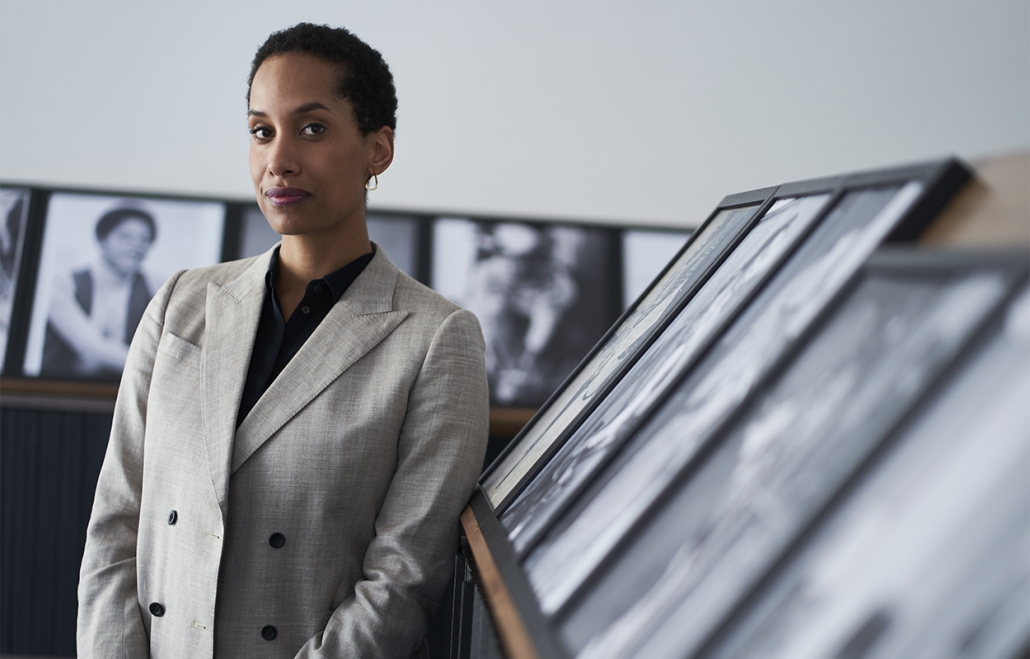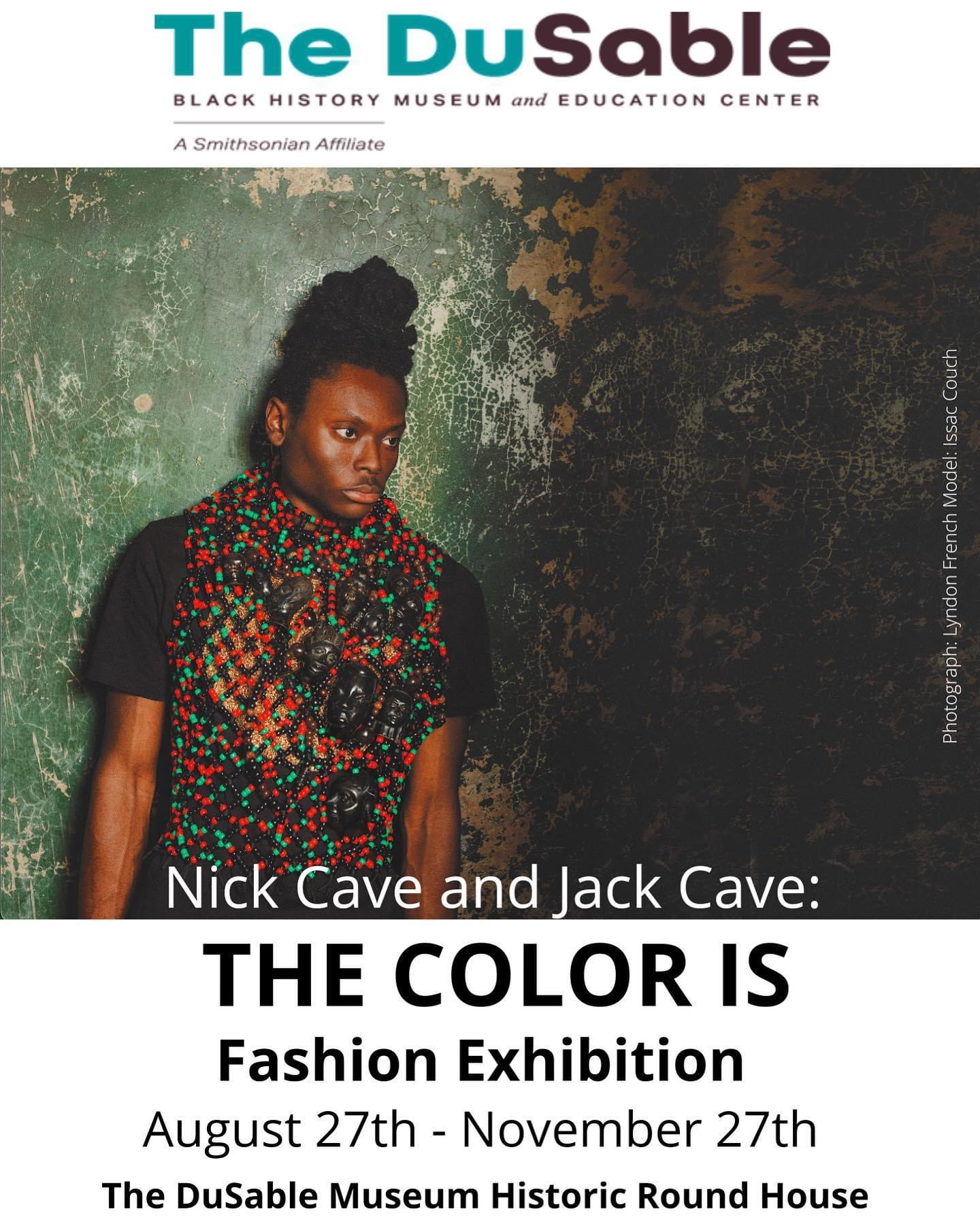This week in Black art and culture, we share the deeply tragic loss of Roderick Sykes, the co-founder of the Los Angeles art center, St. Elmo Village. Sloan’s Ghostlight Productions x BroadwayHD bring the inaugural Obsidian Festival to YouTube for the general public. We cover Daisy Desrosiers’ new title of director, another milestone of Black women’s leadership in the art world. The Pérez Art Museum Miami awards María Magdalena Campos-Pons the 2021 Pérez Prize.

Above: Roderick Sykes with his work (from Jaqueline Sykes)
Pioneer Roderick Sykes Passes On
Roderick Sykes, co-founder of St. Elmo Village, has passed at 75 years old. His mid-city Black art enclave and cultural center nurtured thousands of artistic minds and acted as a meeting spot for civil rights leaders.
St. Elmo Village began in 1969 by Sykes and his uncle, Rozzell Sykes, both visual artists. The place was originally a derelict cluster of 10 Craftsman bungalows between Venice Boulevard and La Brea Avenue, which the two men cleaned up and used as a forum for citizens of all ages involved in artistic pursuits.
Sykes worked on the board of directors and over the years, looked after the neighborhood as though it were his child, sweeping the streets and picking up garbage. He designed workshops for painting, illustration, sculpture, photography and African drumming. He led tours, presented seminars at high schools, gave motivational speeches at colleges and universities, and met with lawmakers.
Roderick Sykes was born in St. Louis on February 20, 1946 to a single mother. Sykes’ mother moved the family to San Diego when he was nine years old, where he attended high school before heading to Los Angeles to focus on his craft. He teamed up with his uncle to hold an art fair in 1969 to raise the $60,000 they needed to buy the quarter-acre property that would become St. Elmo Village.
Sykes’ art appeared in exhibitions, and he created murals on the A&M Records, Pacific Telephone Company, and CBA recording studio offices. He was one of a collective of muralists hired to color on highway walls and underpasses for the 1984 Summer Olympics. St. Elmo Village became a charity in 1971, occupying property that was once silent film star Mary Pickford’s horse farm and named for the street where it is located.
When Sykes was 18, he moved into one of the bungalows and stayed with other tenants who came and went until his death. Throughout the city, St. Elmo Village comprises a gallery, a gathering hall, an art library, a photography studio and darkroom, and a digital graphics workshop. The charity also runs a six-unit apartment building nearby and is converting a three-bedroom house into artist-in-residence space.
Sykes is survived by his wife Jacqueline Alexander-Sykes; daughter Tonya Sykes; sister Terry Ivery; three grandchildren; and 11 great-grandchildren.
Obsidian Festival on YouTube with Sloan’s Ghostlight Productions x BroadwayHD
Sloan’s Ghostlight Productions revealed this Wednesday that it would collaborate with BroadwayHD to deliver the first Obsidian Festival to audiences for free through the streaming service’s YouTube channel. The Obsidian Theatre Festival is a virtual theatre and creative arts series in Detroit that features young Black performers, writers, directors and playwrights.
Viewers of BroadwayHD outlets are invited to register and contribute to one of three charity organizations at obsidianfest.org: Black Theatre United, Detroit Public Schools Foundation or Project Art Detroit. Sloan and the festival’s Co-Executive Producer David Carroll revealed they were accepting all new work in the fall of 2020. The response was overwhelming, with over 200 authors, composers and lyricists submitting work.
Despite the quarantine, the Ghostlight team was able to rehearse, stage and film six productions in person without a single one of the 100-person crew becoming ill. The festival showcases Black stories created in Detroit by Detroiters, spotlighting the prolific work of young Black voices, while drawing on the overwhelming array of varied perspectives in the African diaspora in America. Six featured plays will be performed at the event, as well as regular cabaret shows.

Above: Daisy Desrosiers. Photograph by Gabe Souza.
Daisy Desrosiers Named Head of Gund Gallery
Daisy Desrosiers has been appointed director and head curator of Kenyon College’s Gund Gallery. Gund Gallery was established in 2011. The gallery, which is located in Gambier, Ohio, represents Kenyon students as well as the general public. Desrosiers will oversee exhibit development and public programming, as well as the Gallery’s vast selection of modern and contemporary art, which includes pieces by artists such as Roy Lichtenstein, Louise Nevelson, Ragnar Kjaransson and Julie Mehrtu.
Desrosiers is currently the head of artist services at the Colby College Museum of Art’s Lunder Institute for American Art in Waterville, Maine. She worked at Colby as the director of artist services at the Lunder Institute for American Art, where she was responsible for the institute’s artist partnerships, cultural projects, magazines, exhibits and public programming.
Her appointment at the Gund Gallery was announced on April 12. She formally begins on June 1. An interdisciplinary art historian and director, she will supervise an eight-person team. Collaborations with faculty, teachers and interns will be an important part of her job. Every year, approximately 60 Kenyon students are able to supplement their undergraduate studies with realistic and substantive educational and job opportunities at the gallery, collaborating with museum staff in a number of departments through the Gund Associate Program.
Desrosiers graduated from the Université de Montréal with a bachelor’s degree in art history and a master’s degree in art history from the Université du Québec à Montréal.
Desrosiers also has represented private owners and municipal collections. In 2018, she was named the first Nicholas Fox Weber Curatorial Fellow at the Glucksman Museum in Cork, Ireland, and she completed a curatorial internship at Art in General in New York. She was the curator of Battat Contemporary, a commercial art gallery in Montréal, from 2012 to 2017.

Above:Franklin Sirmans, María Magdalena Campos-Pons, Darlene Pérez, and Jorge Pérez at PAMM Art of the Party. Photo: WorldRedEye.com
María Magdalena Campos-Pons Receives 2021 Pérez Prize
The seventh annual Art of the Party was held at Pérez Art Museum Miami (PAMM) this past Saturday, where Cuban artist Maria Magdalena Campos-Pons was named the winner of the 2021 Pérez Prize, a $50,000 unregulated award that recognizes creative excellence and is financed by a donation from local arts patrons and lifelong PAMM backers Jorge and Darlene Pérez.
Guests toasted Campos-Pons’ creative accomplishments and praised Miami’s resilient arts culture, which has faced enormous obstacles in the last year. The Pérez Prize exemplifies PAMM’s and the Pérez family’s mutual contribution to elevating dynamic creative voices in modern art. Last year’s award went to Puerto Rican artist Daniel Lind-Ramos, whose work explores the heritage of African diasporic cultures and Latin American history through an Afro-Caribbean prism.
PAMM has raised more than $500,000 for its comprehensive arts education services, which have supported more than 300,000 children since its inception in December 2013. PAMM Director Franklin Sirmans presented the award to Campos-Pons, noting her monumental creative achievement at the ceremony.
Campos-Pons, a Nashville-based performance artist and Vanderbilt University professor of visual arts produces critically conscious works that are mostly autobiographical and deal with patriarchy, immigration and feminism. She was born in the Cuban province of Matanzas in 1959, the descendant of enslaved Nigerians. Her African ancestors, owned by sugar plantation slaveholders, handed down African customs that inspired and became part of Campos-Pons’ art.
Ms. Campos-Pons is also of both Chinese and Hispanic ancestry; while her African ancestors served as slaves and house servants on sugar plantations, her Chinese ancestors served in sugar mills as indentured servants. She is a founding member of the New Cuban Art Movement, which was established in the late 1980s to protest Communist repression in Cuba. She moved to the United States in 1991, where she taught at Tufts University’s School of the Museum of Fine Arts.
Allied with Power: African and African Diaspora Art from the Jorge M. Pérez Collection, a display of over 40 works by global African and African diaspora artists on display from Jorge Pérez’s collection, contains many of Campos- Pons’ works in the museum’s permanent collection, as well as a selection of Polaroid prints named The Magician’s Tools. It is open until February 6, 2022.
-Compiled by Sumaiyah E. Wade










